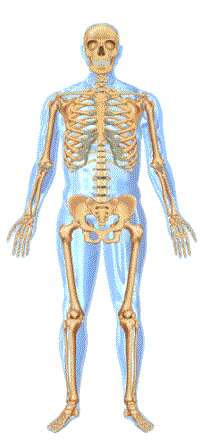Bones make up the skeleton, the solid supportive tissue of the body. Beside their function of support, some bones also contain marrow, responsible for the production of blood cells. Bones also act as a reservoir for calcium and other salts necessary for normal bodily function. They consist of an outer lining, called the periosteum, covering a matrix of connective tissue made up of collagen, upon which are deposited calcium salts, mainly calcium carbonate and calcium phosphate. The outer layers of bones are usually very dense and they're called compact, while the inner layers are less dense, and called cancellous, spongy or trabecular. In bones responsible for marrow formation (not all bones are), such as the vertebrae (the spine), the sternum (the breastbone) or the femur (the thigh bone) the marrow lies in a cavity in the middle. The structure of bone may be thought of as being something like reinforced concrete, with the collagen fibres being the steel framework, and the calcium salts being the cement. They are continually being remodelled by the action of cells called osteoblasts, which absorb bone salts and collagen, and osteoclasts which redeposit them. While the action of the cells is particularly important during, for example, the healing of a fracture, their everyday function is essential for the maintenance of bone strength, since they reabsorb old bone which has become brittle, and deposit new bone in its place - a process which takes months.


 - Tell me more about the bones and joints.
- Tell me more about the bones and joints.